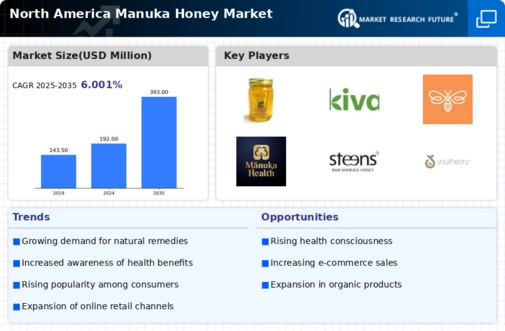The North America Manuka Honey Market has been witnessing considerable growth in recent years, driven by a surge in health-conscious consumers and increasing awareness about the unique properties of Manuka honey. With a rising interest in natural and organic products, this market has attracted numerous players positioning themselves strategically to enhance their market share. Competitive dynamics in this region are characterized by product innovation, effective branding, and the establishment of strong distribution channels.
Companies operate in a landscape marked by the challenge of authenticating the quality of Manuka honey, as not all products labeled as such exhibit the same beneficial properties. Market participants continually strive to communicate the health benefits associated with Manuka honey, particularly its antibacterial and anti-inflammatory qualities, while competing in terms of pricing, packaging, and customer loyalty initiatives. Tahi has established a noteworthy presence in the North America Manuka Honey Market, emphasizing high-quality sourcing and sustainable practices. The brand is recognized for its dedication to providing pure, authentic Manuka honey, which resonates with environmentally-conscious consumers.
Tahi prides itself on its unique storytelling approach, focusing on the origins of its honey sourced from New Zealand, thereby fostering a connection with consumers seeking transparency and quality assurance. The company's commitment to sustainability and ethical production methods strengthens its market position, as it resonates with the ideals of health and well-being that increasingly permeate consumer preferences in North America.
With a robust marketing strategy, Tahi is positioning itself as a premium product, appealing to a niche segment that values high-grade, sustainably sourced honey.Honey Pacifica, operating within the North America Manuka Honey Market, has built a reputation for its diverse range of honey products tailored to meet the varying needs of consumers. The company offers a selection of Manuka honey variants distinguished by different UMF ratings, thereby appealing to both health enthusiasts and casual buyers alike. Honey Pacifica’s strength lies in its extensive distribution network and established relationships with retailers, facilitating broader accessibility of its products across the region.
The company's commitment to quality translates into stringent testing and certification processes, enhancing consumer trust. Additionally, Honey Pacifica has explored strategic partnerships and alliances to expand its market footprint and consistently invests in marketing efforts to promote its product attributes. This combination of quality offerings and effective market strategies positions Honey Pacifica advantageously in a competitive landscape, enabling it to capitalize on the growing demand for premium honey products in North America.


















Leave a Comment